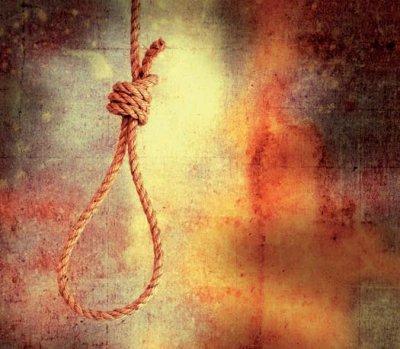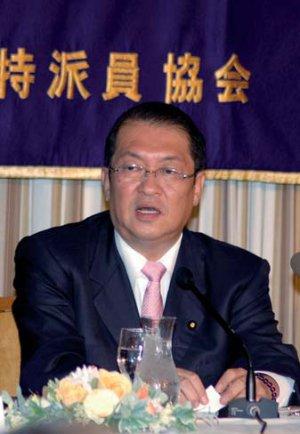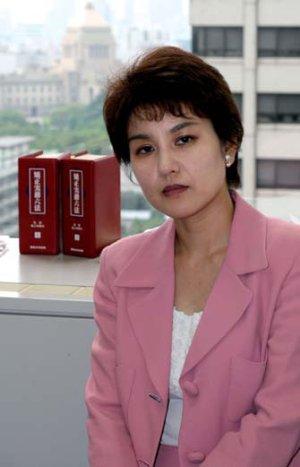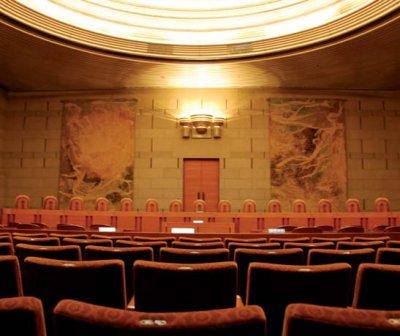Judgement Day

Citizen judges and the future of the death penalty
By Anna Kitanaka
On December 18, 2007, the United Nations General Assembly voted on a landmark resolution calling for a global moratorium on executions, with a view to eventually abolish the death penalty. In all, 104 countries voted in favor, 54 against and 29 abstained. Those against the resolution include Afghanistan, Bahrain, Zimbabwe, Kuwait— and Japan. The European Union, Canada, South Africa and a growing portion of Latin America have already abolished the death penalty. The US and Japan are the only two major industrialized nations left that still hold onto the death penalty, despite the growing widespread movement for abolishment. How long can Japan hold out against mounting international pressure? But more imminently, how will the country’s implementation of the lay judge system affect the outcome of sentencing?
Widespread support only in Japan
 Justice Minister Kunio Hatoyama: dubbed as “The Grim Reaper” by the Asahi Shimbun
Justice Minister Kunio Hatoyama: dubbed as “The Grim Reaper” by the Asahi Shimbun
Polls have announced time and time again that the majority of the Japanese public supports the death penalty, the most recent poll by the Cabinet Office showing an 80% support rate for capital punishment.
“There is strong public support for the death sentence system and for carrying out executions,” Justice Minister Kunio Hatoyama told reporters, hours before the UN General Assembly voted in favor of the resolution at the end of last year. The Japanese government remains strong on the stance that capital punishment will remain a domestic issue, especially considering the high public support, even though the UN General Assembly has repeatedly expressed its deep concern about the continued application of the death penalty, and called upon states that still maintain this penalty to “progressively restrict its use and reduce the number of offences for which it might be imposed.” Despite this, the policy of capital punishment for juveniles shifted from “exceptional” to “in principle,” with the same criteria for death sentences that are applied to adults also being applied to minors. April 2008 saw theory become practice when the Hiroshima High Court upheld the death sentence of a man convicted of the 1999 murder of a mother and her infant child in Hikari, Yamaguchi Prefecture. The defendant was a minor at the time of the crime, setting a new precedent for the death penalty being applied to juvenile offenders.
Public support for the executions mounted, fuelled by the emotional press conferences
The Japan Times reports that the Hiroshima High Court’s decision indicates how “crime victims’ feelings and the social impact caused by the crime have become more essential factors than the number of victims when deciding whether the death penalty is handed down.” This became a hugely high-profile case, with Hiroshi Motomura, the husband and father of the victims, repeatedly making public pleas for the death penalty. Public support for the executions mounted, fuelled by the emotional press conferences from Motomura. Hidemichi Morosawa, Professor of Criminal Law and Victimology at Tokiwa University in Ibaraki Prefecture, told The Japan Times that the public awareness of crime victims’ feelings may have played a part in the judgment. “Japanese courts have long ignored crime victims in trials on criminal cases,” Morosawa said. “It’s natural that the public have come to think that such a situation is wrong.”
Layman’s law
 Criminal defense lawyer and penal system reform researcher Maiko Tagusari
Criminal defense lawyer and penal system reform researcher Maiko Tagusari
And it is this greater emphasis on citizen participation in the judicial process that lies at the heart of the reforms that have led to the adoption of the lay judge system—a sentencing structure which hopes to directly channel ordinary people’s feelings and opinions into the administration of justice. Yet critics argue that the lay judge system, due to be implemented in Japan in May 2009, will be emotionally confusing for the jury who may be unable to distinguish fact from feeling. The Japanese system aims to be efficient, with both the trial and sentencing carried out in one process with the same jury, unlike the US where typically the jury is only responsible for deciding if the defendant is guilty or not—later professional judges deciding on the sentence. The Japanese system will mean that essentially, lay judges will be able to speak to the victims who can express what punishment they would like to see. “It will end up like a free for all,” says Robert Precht, legal consultant for criminal defense lawyers in Japan and experienced defense lawyer for high-profile criminal cases. “This is what alarms me as an American lawyer and I question, will they be able to separate emotions from guilt or lack of guilt? The shielding mechanisms for emotions are lacking in the Japanese system.”
Others agree. Maiko Tagusari, a researcher on penal system reform for the Japan Federation of Bar Associations (JFBA) and also the defense lawyer for the high-profile case of recently executed Tsutomu Miyazaki, says “of course the lay judges will hesitate on the death penalty as you have a real human in front of you whose fate you are deciding. But on the other hand, you are facing the victims’ voices and it’s very diffi- cult to ignore these. I think, in the end there will be more death penalty sentences with the lay judge system.”
I think, in the end there will be more death penalty sentences with the lay judge system
The JFBA have conducted various mock trials over the course of the year, with results showing that lay judges tend to choose more severe sentencing than initially expected. However, Tagusari believes that this might be the cause of lay judges being influenced by professional judges. She claims to have seen cases where lay judges first tend to choose lesser sentencing, but then the professional judges advise them that similar past cases have not yielded such light results, easily affecting the lay judges’ decision making process.
However, Matthew J Wilson, special advisor to the JFBA and Associate Professor of Law at Temple University, holds a more optimistic view about the effectiveness of the new system: “I do think it [death penalty convictions] will rise, but not considerably, as there will be systems in place.” One of the systems he is referring to is a database containing information on past cases so that lay judges can search for similar crimes and see what the sentence given was, to act as an “emotional check.”
Fact from fiction

Seemingly misconstrued ideas of rising crime rates from the Japanese public are also a concern when it comes to reform of the sentencing process. The National Police Agency reports that serious offences are falling each year, a continuous trend since 2004. According to a 2006 white paper on crime, murders have also declined, with 2006 seeing 1,309 murder cases, down 6% from the year before. Yet death penalty convictions are continuously increasing, with over 100 inmates on death row, the highest since 1946. Executions are also happening at an increasing pace—Justice Minister Kunio Hatoyama, who took office in August 2007, signed off on the 13th execution of his tenure in June 2008. It is the highest number under one justice minister’s tenure since executions were resumed in Japan in 1993—the Asahi Shimbun dubbed him the “Grim Reaper” in a recent article.
With growing frequency of executions, and a number of high profile cases such as the Akihabara massacre and inter-familiar murders, there seems to be a mistaken perception in Japan that murder is increasing severely. But the truth remains that Japan is one of the safest nations in the world, with amazingly low crime rates. Wilson attributes part of the cause to the domestic media, for who sensationalist reporting on murder cases is the dominant mode. Whether abolitionist or retentionist, it is universally agreed that there is a lack of civic knowledge and debate about the death penalty. “It is seldom raised by the ordinary papers and they do not recognize the existence of the problems,” says Tagusari. However, she feels the situation is gradually changing; “As legal professionals, we have to provide the media with precise data and penal policy practices. Now is the time to create public discussions about this issue, frankly and plainly. We shouldn’t try to evade these discussions as neglecting these efforts will lead us to have a poor justice system.”
Despite their repeated calls for the abolishment of the death penalty, Amnesty International representative, Norma Kang Muico, is optimistic about the jury system for Japan. “We hope that the introduction of the lay judge system in Japan next year will initiate an informed public debate on the death penalty.”
With the recent controversial broadcasting of an execution recording on the radio stirring up debate, and more voices being heard from both the retentionists and the abolitionists, at least the jury system is doing one of the things it should do—generating more discussion and public awareness about capital punishment in Japan. JI
Unwanted?
Whilst the jury system will be implemented as a means of giving the public more responsibility for the law and to enable better understanding and transparency of the judicial system, polls have actually found that the majority of the public do not want this responsibility. According to the Nikkei Weekly, “A survey conducted this year by the Supreme Court found that only 15.5% of respondents said they want to or are willing to take part in criminal trials as citizen judges. Those who said they would participate reluctantly and only because it was obligatory accounted for 44.8%, while 37.6% said they would not want to serve as citizen judges even if they were obliged to.” And it isn’t just the public—many lawyers are also voicing their concerns and are nervous about the effectiveness of the system.
The Niigata Bar Association became the first regional attorneys’ group to pass a motion asking to postpone the lay judge system. One point of contention is the time restraints on the trials—three days, under the current proposal. “To demand such speed is a joke that can only be called a ‘course administration of justice’ and we are against it,” the Association said. There is also concern over the preparedness of legal professionals to cope with the new system. Law proffesor Matthew Wilson, who has been aiding in the training of defense lawyers, understands that there is still a way to go, but feels more confident than others—“I do think the defense bar will be ready for the implementation of the jury system,” he said.
However, JFBA resercher, Maiko Tagusari, claims that defense attorneys are not equipped with the right training yet: “Although there are courses for most bar associations, they are not enough,” she told us. “Because the courses are not mandatory but on a volunteer basis, and they are held in the evening, there are people like myself who have other commitments and cannot participate, so I feel the training is far from sufficient.”
Statistics:
• Current death row inmates: 103
• Number of executions in 2008 so far: 10
• 2007: 9
• 2006: 4
• 2005: 1
• Number of executions since 1958–2007: 338
• Execution method used in Japan: Hanging
• Support for executions in Japan 2005: 80%
• Increase on 1975: 23%
• Japan’s average conviction rate: 99.8%
• Pro-death lobby group: National Association of Crime Victims and Surviving Families
• Anti-death lobby group: Forum90
• Number of countries that still actively utilize the death penalty: 68
• Number of countries that no longer actively utilize the death penalty: 41
• Number of countries that have abolished the death penalty: 88
• Number of lay judges per trial: 6
• Number of professional judges per trial: 3





